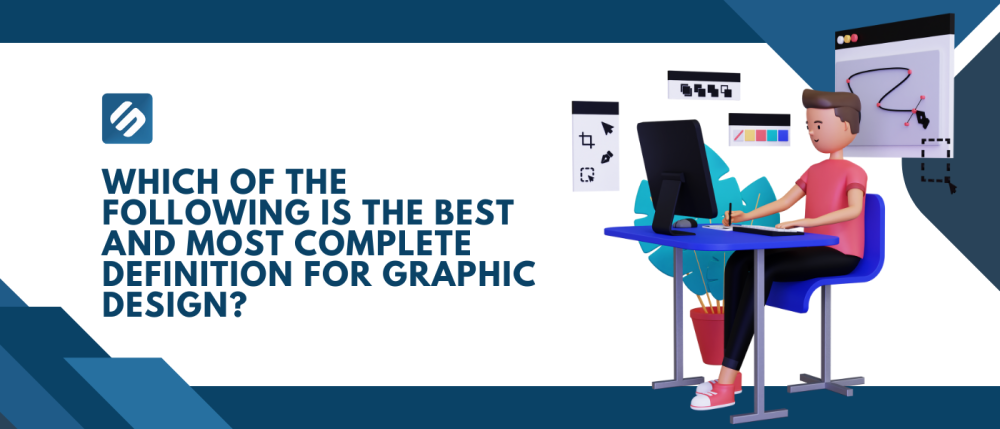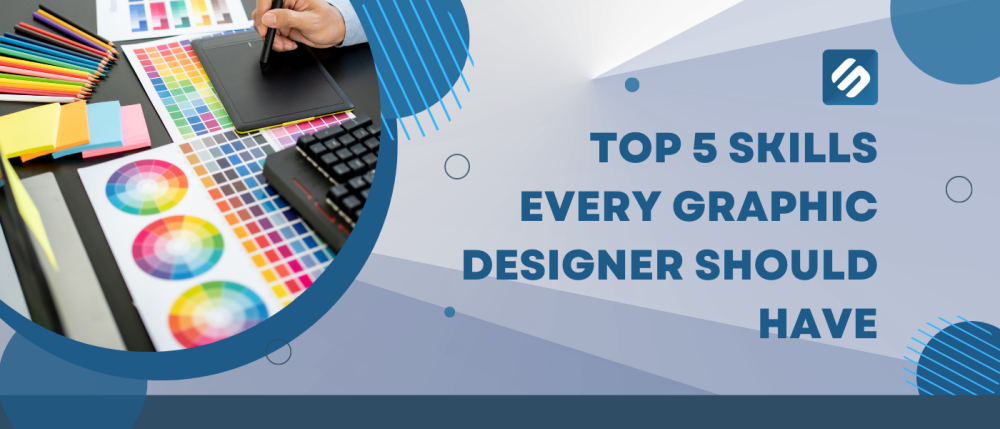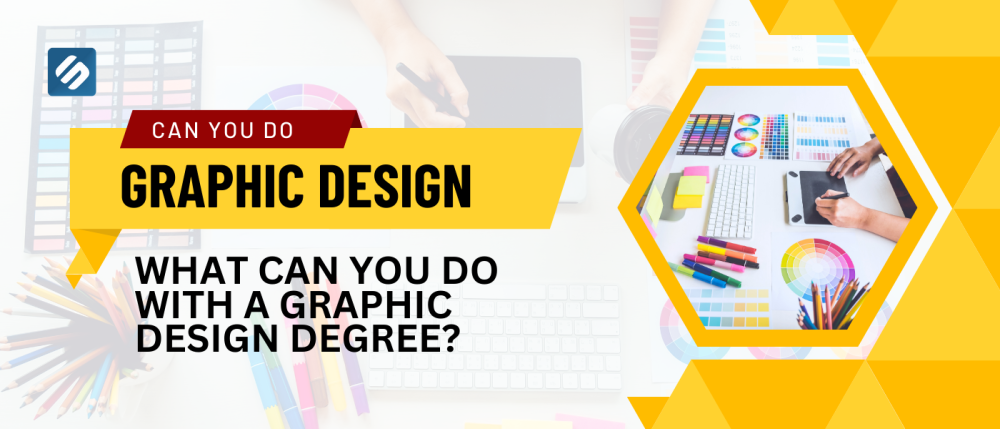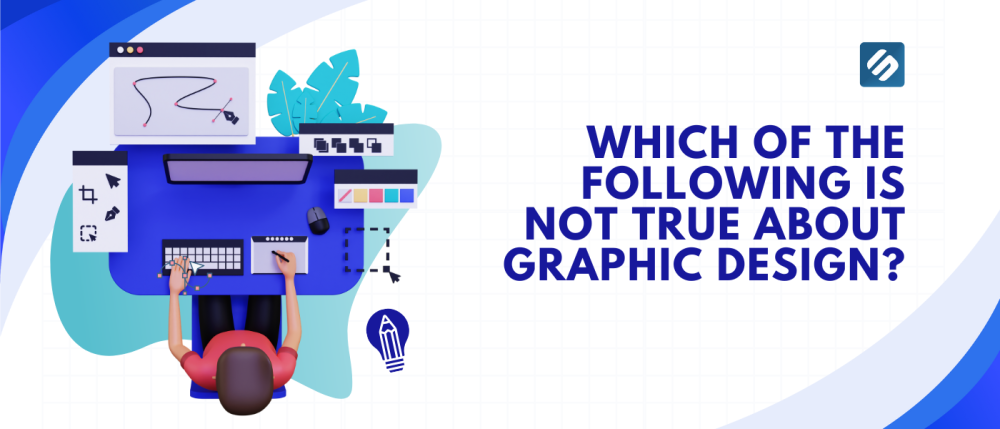Graphic design is a dynamic and ever-evolving field that plays a crucial role in visually communicating messages, ideas, and information to the audience. It combines artistic creativity, technical skills, and strategic thinking to create visual compositions that engage and captivate viewers.
In this article, we will explore the best and most complete definition for graphic design while delving into its various aspects and significance in today's digital age.
What is Graphic Design?
Graphic design refers to the practice of creating visual content using typography, images, colors, and other design elements to communicate a specific message or evoke certain emotions. It is a multidisciplinary field that encompasses various forms of visual communication, including print design, digital design, branding, advertising, web design, and more.
Graphic designers use their creative and technical skills to craft visually appealing designs that effectively convey information, enhance user experience, and strengthen brand identities. They work with clients, marketers, and other professionals to understand their objectives and translate them into visually compelling designs.
The Role of Graphic Design in Communication
Graphic design plays a vital role in communication by visually conveying messages and information to the intended audience. It helps in capturing attention, evoking emotions, and delivering information in a concise and engaging manner. Effective graphic design can communicate complex ideas, simplify information, and enhance the overall user experience.
In today's fast-paced digital world, where attention spans are limited, graphic design helps in grabbing and retaining the viewer's attention. It enables businesses to stand out in a crowded marketplace, differentiate their brand, and create a lasting impact on their target audience.
The Elements of Graphic Design
To create visually appealing and effective designs, graphic designers utilize various elements of design. These elements work together to form a harmonious composition that communicates the desired message. Here are some key elements of graphic design:
1. Typography
Typography involves the selection, arrangement, and styling of fonts to enhance readability and convey the desired tone. Different fonts evoke different emotions and have distinct characteristics, allowing designers to tailor the typography to align with the message and brand identity.
2. Color
Color is a powerful visual element that can evoke emotions, set a mood, and convey meaning. Graphic designers use colors strategically to create visual hierarchy, establish brand identity, and enhance the overall aesthetic appeal of the design.
3. Imagery
Images and illustrations are essential components of graphic design. They help in conveying ideas, representing products or services, and adding visual interest to the design. High-quality and relevant imagery can significantly impact the effectiveness of a design.
4. Layout and Composition
The arrangement of elements, known as the layout, and the overall composition of the design are crucial in creating a visually pleasing and balanced result. Designers consider factors such as hierarchy, alignment, spacing, and visual flow to ensure that the design is easy to comprehend and aesthetically pleasing.
Importance of Graphic Design
Graphic design plays a vital role in various aspects of our daily lives. It has a profound impact on businesses, marketing, education, and entertainment. Let's explore some key reasons why graphic design is essential:
-
Brand Identity: Graphic design helps in shaping a brand's visual identity through logos, packaging, and consistent design elements. It creates a unique and recognizable image that resonates with consumers.
-
Effective Communication: Designers use visual elements to convey messages in a concise and compelling manner. They can distill complex information into visually appealing graphics that are easy to understand.
-
Engaging Content: Eye-catching designs grab attention and create a memorable experience for viewers. Whether it's an advertisement, website, or social media post, well-designed visuals can captivate and engage the audience.
-
Building Trust: Professionally designed materials instill trust and credibility in the audience. A visually pleasing design suggests attention to detail and quality, which positively impacts a brand's reputation.
-
Enhancing User Experience: User-centric design focuses on creating seamless experiences for users. Graphic designers ensure that websites, apps, and interfaces are intuitive, visually pleasing, and easy to navigate.
Principles of Graphic Design
To create visually compelling and effective designs, graphic designers follow certain principles that guide their creative process. Let's explore some fundamental principles of graphic design:
1. Balance
Balance refers to the distribution of visual elements within a design. It can be symmetrical, asymmetrical, or radial. Achieving balance ensures that no single element overpowers the overall composition, creating a harmonious and visually pleasing design.
2. Contrast
Contrast involves using contrasting elements, such as colors, sizes, and shapes, to create visual interest and emphasize important information. It helps in guiding the viewer's attention and adds depth to the design.
3. Typography
Typography plays a crucial role in graphic design. It involves selecting appropriate fonts, sizes, and spacing to enhance readability and convey the desired tone. A well-chosen typeface can greatly impact the overall design's aesthetics and message.
4. Color Theory
Colors evoke emotions and have symbolic meanings. Understanding color theory helps designers create harmonious color schemes that align with the intended message and purpose of the design. Different colors can elicit different moods and responses from viewers.
5. Hierarchy
Hierarchy refers to the organization of elements based on their importance. It guides the viewer's attention and ensures that the most crucial information stands out. Establishing a clear visual hierarchy helps convey the intended message effectively.
Tools and Software for Graphic Design
Graphic designers utilize a wide range of tools and software to bring their creative visions to life. Hereare some popular tools and software used in the field of graphic design:
-
Adobe Creative Suite: Adobe Creative Suite, including Photoshop, Illustrator, and InDesign, is widely used in the graphic design industry. Photoshop is ideal for editing and manipulating images, Illustrator is perfect for creating vector graphics and illustrations, while InDesign is used for layout design.
-
Canva: Canva is a user-friendly online graphic design platform that offers a variety of pre-designed templates and customization options. It's suitable for both beginners and professionals and is widely used for social media graphics, presentations, and marketing materials.
-
Sketch: Sketch is a vector-based design tool specifically created for web and interface design. It provides an intuitive interface and features such as symbols and artboards, making it a popular choice among UI/UX designers.
-
Figma: Figma is a collaborative design tool that allows multiple designers to work on the same project simultaneously. It offers features like real-time collaboration, prototyping, and design system management, making it a preferred choice for design teams.
-
Procreate: Procreate is a powerful digital illustration app designed for iPad. It offers a wide range of brushes and tools, allowing artists and illustrators to create stunning digital artworks with ease.
-
Affinity Designer: Affinity Designer is a professional-grade graphic design software that provides a comprehensive set of tools for vector illustration, photo editing, and layout design. It's a cost-effective alternative to Adobe Creative Suite.
These are just a few examples of the many tools and software available to graphic designers. The choice of software depends on individual preferences, project requirements, and the specific design tasks at hand.
Impact of Graphic Design on Various Industries
Graphic design has a significant impact on various industries, influencing how businesses communicate with their target audience and establish their brand identity. Let's take a look at how graphic design impacts some key industries:
1. Marketing and Advertising
In the marketing and advertising industry, graphic design plays a crucial role in creating compelling visuals for promotional materials, advertisements, and branding campaigns. Well-designed graphics help capture attention, convey messages effectively, and persuade consumers to take action.
2. Web Design and User Experience
Web design relies heavily on graphic design principles to create visually appealing and user-friendly websites. Graphic designers work closely with web developers to ensure that the interface is intuitive, aesthetically pleasing, and provides a seamless user experience.
3. Publishing and Print Media
Graphic design is essential in the publishing and print media industry, where it is used to create book covers, magazine layouts, brochures, and other print materials. It helps in visually representing the content and attracting readers' attention.
4. Entertainment and Gaming
The entertainment industry heavily relies on graphic design for movie posters, album covers, game interfaces, and visual effects. Graphic designers contribute to creating immersive experiences and captivating visuals that enhance the overall entertainment value.
5. Product Packaging and Branding
Graphic design plays a crucial role in product packaging and branding. It helps in creating visually appealing packaging designs that stand out on store shelves and reflect the brand's identity. Effective branding through graphic design can significantly impact consumer perception and loyalty.
The Process of Graphic Design
Graphic design follows a systematic process that enables designers to deliver high-quality designs efficiently. While the process may vary depending on the project and individualpreferences, it generally consists of the following stages:
1. Research and Planning
Before diving into the design process, graphic designers conduct thorough research to gather information about the client, target audience, competitors, and industry trends. This research helps them understand the project requirements and identify potential design directions.
2. Ideation and Concept Development
Based on the research, graphic designers brainstorm ideas and concepts. They sketch rough drafts, create mood boards, and explore different visual directions. This stage allows for experimentation and the exploration of various design possibilities.
3. Design Creation
Once a concept is finalized, designers move on to the creation phase. They use design software to develop digital mockups, combining typography, imagery, color schemes, and layout techniques. Designers pay attention to detail and refine their work to achieve the desired outcome.
4. Review and Feedback
After creating the initial design, designers present it to the client or stakeholders for feedback. This stage involves open communication, collaboration, and making necessary revisions based on the feedback received.
5. Finalization and Delivery
Once all revisions are implemented and the design is approved, it is prepared for finalization. Designers optimize the files for various formats and deliver them to the client or relevant parties. This stage may also involve coordinating with printers or developers for production.
FAQs about Graphic Design
1. What skills do graphic designers need?
Graphic designers need a combination of artistic and technical skills. They should have a strong sense of aesthetics, proficiency in design software, knowledge of color theory, typography skills, and an understanding of the principles of design. Additionally, communication and problem-solving skills are essential in collaborating with clients and bringing their vision to life.
2. Is graphic design only about creating logos and advertisements?
No, graphic design encompasses a wide range of disciplines. While creating logos and advertisements are part of graphic design, it also includes areas such as web design, user interface design,and packaging design, among others. Graphic designers work across various industries and sectors, creating designs for digital platforms, print materials, branding collateral, social media graphics, and more.
3. How does graphic design contribute to branding?
Graphic design plays a significant role in branding by visually representing a company's identity and values. Design elements such as logos, color palettes, typography, and brand guidelines are created to establish a consistent and recognizable brand image. Graphic designers ensure that all visual touchpoints align with the brand's personality and effectively communicate its message to the target audience.
4. What software do graphic designers use?
Graphic designers use a range of software tools to create their designs. Some popular ones include Adobe Photoshop for image editing and manipulation, Adobe Illustrator for vector graphics and illustrations, and Adobe InDesign for layout and print design. Additionally, graphic designers may also use tools like Sketch, Canva, or Figma for web and UI design.
5. How has technology influenced graphic design?
Technology has revolutionized the field of graphic design, providing designers with powerful tools and resources to create innovative designs. The availability of digital platforms and software has made design more accessible and streamlined collaboration processes. Advancements in printing techniques, animation, and interactive design have expanded the possibilities for graphic designers to create engaging and dynamic visuals.
6. Is graphic design a growing field?
Yes, graphic design is a growing field with increasing demand in various industries. As businesses continue to recognize the importance of visual communication and branding, the need for skilled graphic designers is on the rise. Additionally, the growth of digital platforms and the continuous evolution of technology offer new opportunities for graphic designers to explore innovative design solutions.
7. Can I become a graphic designer without formal education?
While a formal education in graphic design can provide a solid foundation and enhance your skills, it is possible to become a graphic designer without a degree. Building a strong portfolio, continuously learning and practicing design principles, and staying updated with industry trends can help you establish yourself as a graphic designer.
8. How does graphic design contribute to user experience (UX) design?
Graphic design and UX design are closely intertwined. Graphic designers play a crucial role in creating visually appealing interfaces, selecting appropriate colors and typography, and ensuring that the design elements are intuitive and user-friendly. A well-designed user interface enhances the overall user experience and encourages user engagement.
9. What is the future of graphic design?
The future of graphic design is bright and ever-evolving. With advancements in technology, graphic designers are exploring new mediums such as virtual reality (VR), augmented reality (AR), and interactive designs. Additionally, the demand for digital content and online branding is expected to grow, creating more opportunities for graphic designers in the digital space.
10. How can graphic design benefit small businesses?
Graphic design is essential for small businesses as it helps create a professional and consistent brand image. Well-designed logos, marketing materials, and website graphics can help small businesses attract customers, build trust, and stand out from the competition.
Conclusion
In conclusion, graphic design is a multifaceted discipline that combines creativity, technical skills, and strategic thinking to visually communicate messages and ideas. It plays a vital role in today's visual-centric world, helping businesses stand out, engage audiences, and effectively convey information.
By utilizing elements such as typography, color, imagery, and layout, graphic designers create visually appealing designs that leave a lasting impression. As technology continues to advance, the field of graphic design will evolve, presenting new challenges and opportunities for designers to showcase their expertise.




